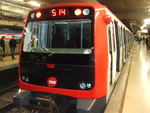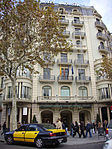Palau Robert

Palau Robert (Catalan pronunciation: [pəˈlaw ruˈβɛɾt]) is a building on Barcelona's Passeig de Gràcia 107, the former private residence of Robert Robert i Surís, an influential aristocrat, politician and businessman at the turn of the 20th century. It's now a government-run institution that hosts an exhibition centre with three halls, a concert hall, a public swimming pool and gardens as well as the Information Centre for Catalonia, including the city's tourism bureau. In the 1936–1939 period, it was the site of the Generalitat de Catalunya's Ministry of Culture. After the Spanish Civil War, Robert's family regained the Palau, until its second purchase by the Generalitat de Catalunya (the Catalan government) in 1981, when it became a public building.
Excerpt from the Wikipedia article Palau Robert (License: CC BY-SA 3.0, Authors, Images).Palau Robert
Passeig de Gràcia (lateral Llobregat), Barcelona
Geographical coordinates (GPS) Address Website External links Nearby Places Show on map
Geographical coordinates (GPS)
| Latitude | Longitude |
|---|---|
| N 41.396185 ° | E 2.15937 ° |
Address
Palau Robert
Passeig de Gràcia (lateral Llobregat) 107
08008 Barcelona
Catalonia, Spain
Open on Google Maps








